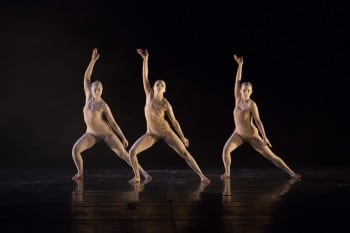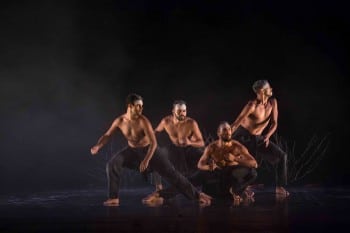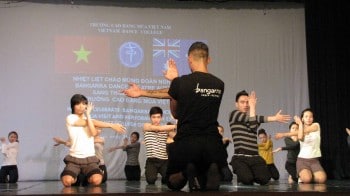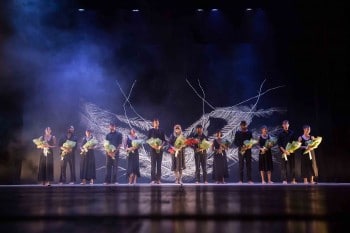Bangarra Dance Theatre – Australia on the International Stage
“We knew we were trying to shift people’s black consciousness and that has always fuelled our passion, our hunt”

Bangarra Dance Theatre is a company with a strong history of producing and performing Indigenous works. Resonating with the sacred history of this land and contemporary narratives that carry our Indigenous stories into the present, this is a company that is unwavering in its commitment to share Australia’s diverse Indigenous experiences with all citizens.
In a recent conversation with Artistic Director Stephen Page, we discussed a range of different topics: the various efforts involved in creating new work; the company’s growing expansion into the international arena; and the ongoing contribution that Bangarra is making to our own Indigenous Arts sector in Australia.
Bangarra’s dancers have an incredibly busy schedule. New works take approximately three months to develop and are then followed by tours around the country to both urban and regional centres. There are also creative developments and time needed to be spent on country; and of course there are international tours.
“Dancers enjoy having that connection to regional and rural communities and simultaneously it’s a wonderful experience to showcase their skills within a mainstream context as well,” explains Page, “We make every effort to ensure that our work is toured to remote Australia as well as all major urban centres and where possible to an overseas audience.”
With over seven months spent in rehearsing and touring the remaining five slip by very quickly, especially with an increasing number of overseas tours. Most recently, the team took Spirit, a collection of highlights from the company’s repertoire, to Vietnam.

“This was part of the 40th anniversary celebrating diplomatic relations between Australia and Vietnam. We were invited to perform in Hanoi and Ho Chi Minh” explains Page.
“And back home in Sydney we were still developing Blak for 2013 so it was a wonderful multi-tasking experience, and very special.”
Page, who was in Vietnam not too long ago working on the choreography for the successful Australian film, The Sapphires, was rapt that the company was given this opportunity.
“It’s an honour and huge privilege to be able to represent Australia and showcase a very unique style to the audiences in Vietnam,” says Page. “We only performed twice and on both occasions it was in a formal settings so the real highlight was actually what came after, the opportunity to work with students and kids off the street.”
Taking part in workshops with the Vietnam Dance College and the Hanoi Youth Theatre as well as participating in masterclasses with the Vietnam Opera and Ballet, the company had a full schedule but, as Page points out: “We always made it a priority to share the skills, stories and talents of our dancers, and the chance to work with locals was one the most memorable experiences.”

“For many of the dancers this was their first time in Vietnam and we were able to offer intensive workshops but also master classes in which 28 students from the local high school participated; it was a fabulous experience working with young people.”
And Vietnam wasn’t the only stop in the Asian tour, six of the dancers also travelled to Bangkok to host a workshop and Masterclass at the Bangkok Dance Academy before returning back home and preparing for the 2013 season.
“The company is now in its third decade,” says Page, “and we are growing into a cultural foundation, both on a practical scale but also with the risks we take and the initiatives we want to establish.”
As a pillar of Australia’s Indigenous performing arts industry Bangarra’s role is significant, not only in creating opportunities for talented Indigenous dancers but also in ensuring that their stories are heard by all Australians.
[pull_left]Arnhem land is a deep spiritual resource for us and we spend time on country because that’s what the work needs[/pull_left]
“There is a balance to creating work and we are continuously developing,” confides Page.
“Arnhem land is a deep spiritual resource for us and we spend time on country because that’s what the work needs – we want it to be true to its source – and that has inspired our practice and will continue to do so because we are sharing our history.”
But sharing stories, particularly Indigenous stories, requires not only adroit craftsmanship but also intuition and Page is keenly aware of the need to maintain the integrity of the work in a highly consumer-based society.
“Indigenous storytelling comes through in waves and this country has seen an outpouring of a variety of different dance forms, both contemporary and traditional, as well as those that meld both. Theatrical forms that have elements of fiction as well as those that are strongly autobiographical … they each have a place in the landscape of diverse Indigenous performance. We each respond to the muse in different ways … as Australians we are developing a diversity of consciousness and that is a very healthy asset to our people.”
Australia has come a long way in recognizing the myriad of different expressions offered by the Indigenous artists of this country but the question remains how long do we need to wait until mainstream audiences ‘catch up’?
It is a question that many artists and companies face, especially as they orientate themselves into an economy that is slowly grasping the concept that cultural knowledge and resources equate to more than simply cultural capital. But Page’s response is optimistic.
“We live in a society now where our general mainstream audience certainly is ‘catching up’, but that is a result of a society that has been defined to a large extent through the modus operandi of ownership. For Indigenous people it has always been about land, people and the spirit of those before and those yet to come, and therein lies a conflict of values and belief systems. But Australia is changing and all Australians contribute to the shifts that take place.”

As a company, Bangarra have always been committed to challenging one dimensional perspectives and Page is determined that the spirit of questioning will never falter.
“We knew we were trying to shift people’s black consciousness and that has always fuelled our passion, our hunt,” says Page.
“As we continue to grow and expand our stories and our skills as storytellers continue to grow. We are part of a history, a legacy and those vows to carry those stories with truth and integrity will always be a cornerstone of Bangarra’s values.”
Whether at home in Australia or performing overseas, Bangarra Dance Theatre is certainly an icon, not merely reflecting the artistic and aesthetic richness of our Indigenous peoples but also how far we have come as Australians. And with a history of over 40,000 years that’s a very long way indeed.
